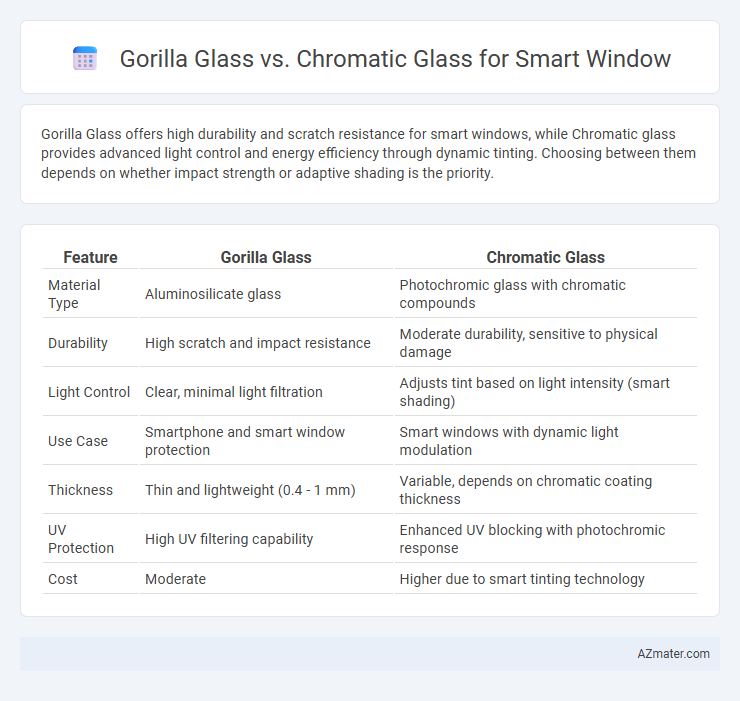Gorilla Glass offers high durability and scratch resistance for smart windows, while Chromatic glass provides advanced light control and energy efficiency through dynamic tinting. Choosing between them depends on whether impact strength or adaptive shading is the priority.
Table of Comparison
| Feature | Gorilla Glass | Chromatic Glass |
|---|---|---|
| Material Type | Aluminosilicate glass | Photochromic glass with chromatic compounds |
| Durability | High scratch and impact resistance | Moderate durability, sensitive to physical damage |
| Light Control | Clear, minimal light filtration | Adjusts tint based on light intensity (smart shading) |
| Use Case | Smartphone and smart window protection | Smart windows with dynamic light modulation |
| Thickness | Thin and lightweight (0.4 - 1 mm) | Variable, depends on chromatic coating thickness |
| UV Protection | High UV filtering capability | Enhanced UV blocking with photochromic response |
| Cost | Moderate | Higher due to smart tinting technology |
Introduction to Smart Window Technologies
Smart window technologies utilize advanced materials like Gorilla Glass and Chromatic Glass to enhance energy efficiency and user comfort. Gorilla Glass offers exceptional durability and scratch resistance, making it ideal for structural integrity in smart windows. Chromatic Glass incorporates electrochromic or photochromic properties, enabling dynamic control of light transmission to optimize indoor temperature and lighting conditions.
Overview of Gorilla Glass
Gorilla Glass is a chemically strengthened, ultra-thin aluminosilicate glass known for its exceptional durability and scratch resistance, making it ideal for smart window applications that require high impact protection and long-term reliability. Engineered by Corning, this glass offers enhanced clarity and transparency, essential for maintaining optimal visual performance in smart windows integrated with advanced display and sensor technologies. Its lightweight yet robust nature also supports energy-efficient smart window designs by enabling thinner, lighter panels without compromising strength or functionality.
Overview of Chromatic Glass
Chromatic glass for smart windows utilizes photochromic or thermochromic technology to dynamically adjust transparency and light transmission based on external stimuli like sunlight or temperature. Unlike Gorilla Glass, which primarily offers high durability and scratch resistance for device screens, chromatic glass focuses on energy efficiency by reducing glare, heat gain, and UV radiation in buildings. This adaptive functionality supports sustainable architecture by improving indoor comfort and lowering HVAC costs through smart light modulation.
Durability Comparison: Gorilla Glass vs Chromatic Glass
Gorilla Glass offers exceptional scratch resistance and impact durability due to its chemically strengthened composition, making it highly resilient in smart window applications. Chromatic glass, enhanced with smart tinting technology, provides moderate physical durability but excels in functional performance by adjusting light transmission properties. For smart windows requiring robust protection against physical damage, Gorilla Glass is superior, whereas Chromatic glass prioritizes dynamic shading capabilities with balanced structural strength.
Optical Performance and Clarity
Gorilla Glass offers superior optical clarity with high light transmittance and minimal distortion, making it ideal for smart windows requiring clear visibility and durability. Chromatic glass, engineered for dynamic tinting and energy efficiency, may introduce slight color shifts that can affect visual clarity but effectively reduce glare and heat. Both materials balance optical performance, with Gorilla Glass excelling in transparency and Chromatic glass optimizing environmental control.
Energy Efficiency and Insulation
Gorilla Glass offers robust durability and scratch resistance but has limited impact on energy efficiency and insulation in smart windows compared to Chromatic Glass, which actively adjusts tint to control solar heat gain and reduce cooling loads. Chromatic Glass enhances thermal regulation by modulating light transmission, thereby increasing energy savings through reduced reliance on HVAC systems. The dynamic optical properties of Chromatic Glass outperform Gorilla Glass in maintaining indoor temperature stability and improving overall building energy performance.
Smart Features and Customization
Gorilla Glass offers robust durability and scratch resistance, making it ideal for smart windows requiring high longevity and clarity. Chromatic glass excels in smart features like dynamic tinting and color-changing capabilities, allowing real-time light control and energy savings. Customization in Chromatic glass is advanced with adjustable opacity and hue settings, while Gorilla Glass primarily focuses on structural strength with limited smart modulation options.
Installation and Maintenance Differences
Gorilla Glass for smart windows offers high durability and scratch resistance, making installation easier due to its robust surface that reduces the risk of damage during handling. Chromatic glass, with its integrated photochromic technology, requires more precise installation procedures to ensure optimal electronic connectivity and uniform tinting performance. Maintenance for Gorilla Glass is typically lower due to its tough surface, while Chromatic glass demands specialized care to preserve its adaptive light control properties and electronic components.
Cost Analysis and Market Availability
Gorilla Glass, manufactured by Corning, is widely used in smart windows due to its superior strength, scratch resistance, and cost efficiency, with prices typically ranging between $10 to $20 per square foot depending on thickness and customization. Chromatic glass, known for its dynamic light modulation and energy-saving benefits, generally commands a higher premium, often exceeding $30 per square foot, limiting its immediate market availability to premium architectural and automotive applications. Market data indicates Gorilla Glass dominates mass-market smart windows, while Chromatic glass is gaining traction in niche segments due to evolving consumer demand for advanced aesthetics and sustainability features.
Best Applications: Choosing the Right Glass for Your Smart Window
Gorilla Glass offers superior durability and scratch resistance, making it ideal for high-traffic smart windows in commercial buildings and public spaces. Chromatic glass features dynamic light modulation with color-changing capabilities, perfect for energy-efficient residential windows and adaptive architectural designs. Selecting the right glass depends on whether impact resistance or advanced solar control and aesthetic flexibility are the priority for your smart window application.

Infographic: Gorilla glass vs Chromatic glass for Smart window
 azmater.com
azmater.com